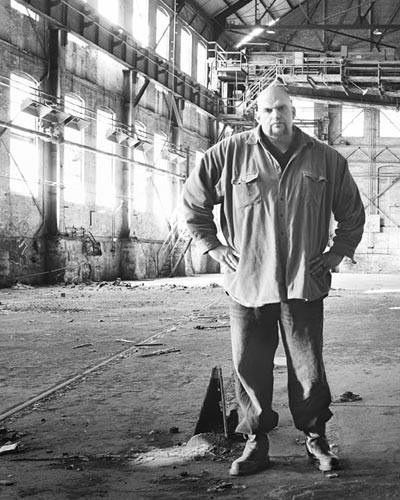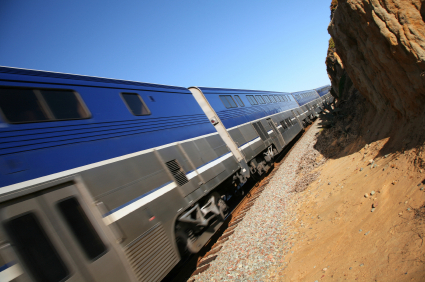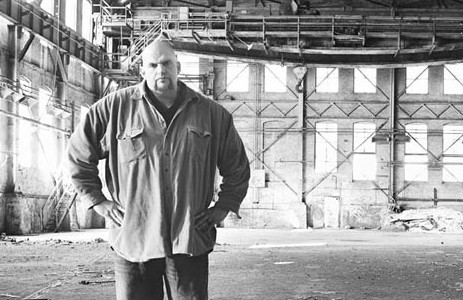 Mayor John FettermanPhoto: The Cap SolutionJohn Fetterman is not easy to miss. He’s 6’8″, 325 pounds, and usually dressed in a black work shirt and boots. He sports two large tattoos on his forearms, a shaved head, and a goatee. You might mistake him for a steelworker at first glance, but he’s actually the 40-year-old, Harvard-educated mayor of Braddock, Pa.
Mayor John FettermanPhoto: The Cap SolutionJohn Fetterman is not easy to miss. He’s 6’8″, 325 pounds, and usually dressed in a black work shirt and boots. He sports two large tattoos on his forearms, a shaved head, and a goatee. You might mistake him for a steelworker at first glance, but he’s actually the 40-year-old, Harvard-educated mayor of Braddock, Pa.
Fetterman has become a poster boy for the clean-energy revolution, thanks to an Environmental Defense Fund ad campaign that features him calling for climate and clean-energy legislation to help revitalize former steel towns like Braddock. He’s appeared before Congress twice to testify in support of the Waxman-Markey climate bill, arguing that a cap on carbon will help towns like his recover.
Braddock was once a thriving steel town along the Monongahela River, the place where Andrew Carnegie made his fortune in steel. The town’s population was over 20,000 in the 1950s, but the bottom began to fall out soon thereafter. Steel jobs left, and with them, the town’s prosperity and population. The town now has fewer than 3,000 residents, and empty houses and vacant lots line the streets. Unemployment runs about three times the national average, and the median household income is just $18,473.
Fetterman, a native of York, Pa., moved to the town in 2001 after graduate school at Harvard’s Kennedy School of Government, to start a program for young adults. He was elected mayor of the city in 2005, and since then has made revitalizing the town his top priority. He has Braddock’s zip code, 15104, tattooed on one arm, and on the other are the dates of killings that have occurred during his time in office, along with the words “I will make you hurt.”
In the past four years, the town has launched a green-jobs summer program for youth, created a green space for the community, and brought a small alternative energy company, Fossil Free Fuel, to the downtown area. Plans are underway for a community center powered by geothermal energy.
Earlier this year, Fetterman and his town were featured in a New York Times article; it caught the attention of the Environmental Defense Fund, which enlisted Fetterman in its ad campaign in support of the House climate bill. The ads show the abandoned streets of Braddock and unemployed steelworkers from the region, with Fetterman calling for “a cap on carbon pollution” to “create jobs making things like solar panels and wind turbines.”
Grist caught up with Fetterman in Pittsburgh, Pa., recently to talk about his town and the hope for a green-job revolution. “At the end of the day, we need to build pragmatic solutions in environmental stewardship, of course, but we also have to make sure we’re taking care of the other side of the socioeconomic coin, [those who] don’t have the luxury of being able to care which kind of heirloom tomato they buy,” he told Grist.
—–
Q. Tell me about Braddock.
A. Braddock is steel town a little bit outside of Pittsburgh. It was once an incredibly prosperous boomtown of 20,000 residents, and it’s now under 3,000. It’s a 90 percent loss in our population, and now 90 percent of our businesses are gone, 90 percent of our building stock is gone. It really grabs you. You can tell something really bad happened, but you’re not sure what. You can’t get 90 percent of the population to agree that the sky is blue, but 90 percent of people agreed that we need to leave here because things are in such a state that we don’t have any other options.
Q. When did it start getting bad for Braddock?
A. This was well before I arrived on the scene. It started in the ’60s. It was nothing really significant, but it was a trickle. And then it accelerated in the ’70s, and then the mills started dropping rapidly, then it really descended into chaos. It’s like the Warren Zevon song, “We were in the house when the house burned down.” And the people that remained have really gone through this kind of economic apocalypse, where it’s 28 days later and they’re kind of like the survivors of this scourge that was beyond their control. There was very little they could do as an individual besides hold on and try to maintain some semblance of the life they knew growing up, when Braddock had 13 furniture stores, three movie theaters, dozens and dozens of bars, restaurants, department stores, all of these things. And now there’s none. We don’t have any.
Q. What do people who live in Braddock now do?
A. Well, many of them are unemployed. Many work in the service sector, in a large retail and lifestyle complex that’s down the river. Some work in the hospital that’s still in town, and some commute to Pittsburgh for other jobs.
Q. Where did the green-jobs idea come from? What was the inspiration for your work on that?
A. Braddock and Pittsburgh need to continually be progressive and advance that frontier. That’s something that I’ve always been involved in and believed in strongly. Urban agriculture, for example. Braddock has this enormously large inventory of vacant lots. What’s the best way to marry the needs of the community with the realities we have in town?
We have kids that don’t have summer jobs. We don’t have any grocery stores in town, and we’ve got this large number of lots. Well, let’s build a small-scale urban farm. That way we create jobs. We create fresh organic produce. We use and beautify a lot that looked like it was a research-and-development lab for different weeds — they were waist high! It serves the community, and also does it in a way that is consistent with a sustainable, more progressive lifestyle. So from my perspective it’s a win-win.
It’s not a matter of having this fetish saying, I compost, so I can pat myself on the back. It’s saying what can we do as a community that improves the quality of life for our residents — and that we’re able to do it in a way that’s sustainable and adheres to these principles, that’s just icing on the cake.
Q. Tell me more about the green-jobs summer program in Braddock. What kind of projects are young people working on?
A. Well, it started when I took office, and this summer we hired close to 100 kids. [They’re] working on the urban farm, creating a green space. Prior to us taking over, our community did not have a green spot for children to frolic, people to just kind of relax. So we have that now. We got a grant from the Heinz Endowment, which is a major local foundation, and we’re working on installing the first green roof in the area too. This is the last building of its kind, an eight-story building, that if we didn’t put a new roof on it eventually, it would go under. So we said, OK, we can put it as a green roof.
That’s the recurring theme for us in Braddock — it has to work with the framework we’re in. It’s not green at the expense of Braddock, it’s what’s right for Braddock, and thankfully I think it drives home why a lot of these principles really do make sense and it’s not just a bunch of “weird treehuggers” who care about these things. They are important principles not only for the environment but for helping communities as well.
We started [the green-jobs program] in 2006, with a limited number, and we scaled it up. It was 35 the first year, 50 the second, 70 last year, and now it’s 100. And each year we’ve had completion rates well into the 90s. And this year, again, it was 100 percent. I know that’s hard to believe. I wouldn’t believe it if I hadn’t seen it myself. None of the corresponding stereotypes of bad movies that star white folks that come in and change a poor school — we didn’t have the fighting, none of these things.
Q. How did you get involved in the national debate about the climate bill?
A. When The New York Times did a story, I guess I caught the attention of the Environmental Defense Fund. They had ideas, and they were good. But I really wanted to make it much more authentic, because you see a lot of these cheesy environmental ads, where it’s the guy who looks like a model putting on a hard hat. It’s not real. He’s got manicured hands.
The people that are already in your corner are obviously the ones you don’t have to convince. It’s the working-class folks that might get their news from Fox, or may have grown up in more conservative circumstances. Say, look, you don’t have to consider yourself an environmentalist. You can drive your pickup truck, you can live your life the way you want to. But wouldn’t it make sense to not only care for our environment but also create and replenish the critical mass of blue-collar jobs in this community, this country? We still have to make things in this country. I’m very much a believer in that. You can think that global warming is a myth and the sun revolves around the earth, but here’s how it could benefit your community through this very common-sense approach.
Q. You testified in support of the Waxman-Markey bill. What do you think that would do for a place like Braddock?
A. I don’t know how much it will do for Braddock directly. I think as a whole, it will be a necessary but not sufficient first step to help bring regions back from what they’ve suffered through. It’s not like when you pass it, suddenly it’s going to be hunky-dory. Hopefully it will have the same effect as [the invention of] the internet — the same kind of investment that gave rise to Silicon Valley and Seattle can come back to these manufacturing regions, because we as a nation can’t lose that edge.
Q. Are folks in Braddock receptive to talk about passing a climate bill?
A. Most people are like, “What the hell is cap-and-trade?” It’s kind of like derivatives, where these economists can’t explain what it is. So there’s a lot of esoteric things involved. But when you explain that this is the kind of thing that helped get lead out of paint and acid rain and these other things, and how it can create the demand for steel, they get that. There are 250 tons of steel in a windmill. If we build a million windmills, that’s 250 million tons of steel. They understand that, that gels for folks.
When you say global warming in 75 years will raise the average temperature by a degree and a half, that doesn’t mean anything to me. I’ve got to eat. My house is falling apart. So not playing to people’s concern for the environment, but [being] pragmatic — you want a job again, let’s pass this bill.
And as an added benefit, whether you care about it or not, it’s going to reduce our carbon footprint and make us a leader in the world, as we should be, in terms of reducing our carbon output, and also make us the leaders in technology that we can export to these countries like India and China that have no sustainable manufacturing principles.
Q. Are you seeing any signs of growth yet for Braddock?
A. Sure. There are plenty of green shoots. And first and foremost, it’s enhancing the quality of life in the community and making sure that I don’t put any more dates on my arm. There’s definitely reason to be optimistic, but I’d also be crazy if I suggested that this was something that could be remedied in 5, 10, 15 years. This is a long-term kind of project.
The good news is if things in Braddock can change, if things can get better, if it can be safer and kids have better opportunities, I think that’s a good harbinger for towns where they’ve had nothing as severe as what we’ve gone through.
—–
Fetterman made Grist’s list of badass greens. See who else is on the list.
Watch Fetterman in an EDF ad:



